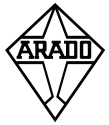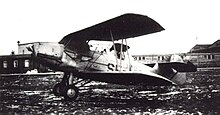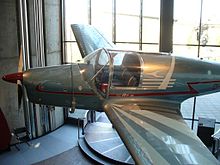Arado aircraft works
| Arado Flugzeugwerke GmbH
|
|
|---|---|
| legal form | Company with limited liability |
| founding | 1921 (as a branch of Flugzeugbau Friedrichshafen GmbH ) |
| resolution | 1961 |
| Reason for dissolution | Removal of the factory facilities according to the Potsdam Agreement and transfer of the machines and devices to the USSR as reparations |
| Seat | Rostock - Warnemünde , Germany |
| management |
|
| Number of employees |
|
| Branch | Aircraft manufacturer |
The Arado Flugzeugwerke was a German aircraft manufacturer from Rostock - Warnemünde . The aircraft yard was established in 1921 on the site and in the halls of the former branch of Flugzeugbau Friedrichshafen GmbH . From 1924 onwards, powered aircraft were produced for various applications, from training aircraft to (later) bombers . There were numerous branches in Germany between 1936 and 1942. The aircraft production ended in May 1945, the company was liquidated in 1961.
history
The Arado Flugzeugwerke GmbH originally firmierten in Warnemünde as a branch plant of the company aircraft Friedrichshafen , in the First World War military seaplanes created. It had to cease its activities at the end of the First World War due to the terms of the Versailles Treaty .
In 1920 Hugo Stinnes bought the factory building in Warnemünde and began manufacturing aircraft again under the name "Dinos Automobilwerke AG" , although these were only intended for export. To this end, Stinnes took a stake in Ikarus AG in what was then Yugoslavia in 1923, under the direction of Erich Serno . Stinnes hired Walter Rethel as chief developer, who had previously worked for Kondor and Fokker .
After Hugo Stinne's death in April 1924, his group was split up and parts of the company were sold. Walter Hormel and the businessman Werner Hansel took over the company in April 1925 in the newly founded Arado Handelsgesellschaft with its headquarters in the Hamburger Hof . On June 18, the Arado trading company was entered in the commercial register, which was entered in the land register on August 10, 1925 as the owner of the Warnemünder facilities. The managing directors were Walter Hormel and Lieutenant Colonel a. D. Felix Wagenführ. At the end of 1925, Walter Hormel left Arado and his shares were taken over by the previous acting managing director Heinrich Lübbe .
From 1926, the S I and S III and their successors, the SC I and SC II, were the first light training aircraft, almost all of which were delivered to the German Commercial Aviation School. Starting in 1927, at least one new aircraft model was introduced every year - both civil mail and commercial aircraft as well as training aircraft for the military such as B. the Arado W II - brought on the market, but only about ten to twelve aircraft per year were sold during this time. In 1929 the design of the two-seater high - decker L I began by the designer Hermann Hofmann, who had a fatal accident with this machine on his European tour in August 1929 . In the same year, Walther Rethel designed the L II based on the L I , which was considered the prototype of the modern sports aircraft. This also remained a unique piece. In 1930 four machines of the enlarged L IIa were built for the 1930 European sightseeing flight , two of which reached the finish in 18th and 22nd place.
After the seizure of power by the National Socialists , the work began in Warnemünde, airplanes for the newly established Air Force to build. Even before this (early 1932) was Rethel by the Ministry of Transport of Walter Blume been replaced as manager, who previously still at Albatros had worked.
In September 1934, construction work began on a branch in Brandenburg an der Havel . The construction of the plant at the Brandenburg-Briest airfield lasted until 1939/1940; Construction of the Brandenburg-Neuendorf plant section began as early as 1937 . On April 11, 1935, the first machine built in Brandenburg-Briest, an Arado Ar 66 training aircraft , left the factory halls.
The Reich Aviation Ministry (RLM) insisted that Heinrich Lübbe must become a party member of the NSDAP . When Lübbe refused, he had to sell his company shares to the Reich in spring 1936. The company name was changed to Arado Flugzeugwerke GmbH . The company shares of the Reich were administered by the Luftfahrtkontor GmbH , founded as a cover company by the Reich Ministry of Aviation . The management of the Arado aircraft works was then the responsibility of Erich Serno and Felix Wagenführ . During this time, Arado gained importance as a supplier for the Air Force , with the Ar 66 becoming the standard training aircraft - well into World War II . Arado also produced two of the first types of fighter aircraft for the Air Force, the Ar 65 and the Ar 68 .
From 1936 to 1943, further Arado branches were established in Rathenow , Anklam , Nowawes / Potsdam-Babelsberg , Alt-Lönnewitz , Landeshut , Sagan and Wittenberg . In addition to the production of Arado aircraft (Ar 95, Ar 96 and Ar 234), the production of fuselages and wings for Heinkel (He 111 and He 177), Focke-Wulf (Fw 190) and Junkers aircraft (Ju 88), e.g. Partly by prisoners of war; the camp was adjacent to the west (after the Second World War until today an allotment garden). After the Second World War, the factory premises were used as Soviet barracks. Today the Wittenberg tax office is in the former administration building; several former workshop buildings were converted into residential buildings.
The heart of the company, the construction department, moved from Warnemünde to Brandenburg in 1935. By 1943, around 80 new aircraft projects were created here under the leadership of Walter Blume, chief designer of the Arado aircraft factory. The central administration was located in Nowawes from 1936 (after the name was changed to Babelsberg).
With the beginning of the Second World War, Arado had risen to become a major supplier for the Air Force. The Ar 96 became the most widely used training aircraft and the Ar 196 , a reconnaissance aircraft, became the standard equipment of the large ships of the German Navy .
More than 20 types of aircraft were built as samples or in series at the Brandenburg plant. Despite extensive license production, the world record aircraft Ar 79 and the world's first combat zone transporter , the Ar 232 , were built here in 1939 . Another well-known aircraft is the Ar 234 , the world's first jet-powered reconnaissance aircraft and bomber. However, the development of this future-oriented aircraft type came too late to play a decisive role in the war. Nevertheless, it set the standard for the development of post-war aircraft.
The number of workers at Arado in Brandenburg / Neuendorf rose from 900 employees in 1935 to 7,900 in 1940 and peaked in 1944 with almost 10,000. As early as 1936, Arado had risen to become the largest company in Brandenburg. As a result of the war and the occupation of European countries, an increasing number of foreign workers came to Arado in Brandenburg; most were Dutch, French, and Czechs. (see also Nazi forced labor )
In July 1935, 3,749 people were employed in all Arado plants, in 1938 14,090 people and by 1942, as a result of drafts, 22,000 German employees were compared to around 4,000 foreign ones. At the end of the year, the number of foreign employees, consisting primarily of foreign workers, prisoners and inmates, had risen to 17,600, while 9,300 German workers were available. On June 30, 1944, the company had the highest number of employees with 30,670 employees.
An American bombing raid on the Arado plant in Heidefeld near Rathenow on April 18, 1944 ended the production of the Heinkel He 177 bomber there , which was previously produced by the Balts, Serbs, Spaniards, French, Dutch and Belgians, who do thousands of forced labor there had to. After this attack, due to the destruction of the boiler house and two of the three large assembly halls, only the lighter Focke-Wulf Fw 190 could be produced. The production was partly taken over by Rathenower companies like the optical factory O. W. Wagener & Co. The Fritz Brucks furnace factory also stepped in for Arado until production could be fully resumed after six weeks.
Further air raids on August 6, 1944 and March 30, 1945 temporarily interrupted aircraft construction. By the time assembly was stopped in April 1945, more than 4,000 machines had left the Brandenburg factory.
The plant in Potsdam-Babelsberg was destroyed on April 14, 1945 .
When the plant in Brandenburg was occupied by the Red Army in early May 1945, aircraft construction ended. In accordance with the Potsdam Agreement , most of the factory facilities were removed, and machines and equipment came to the USSR as reparations .
The facilities in Rathenow became public property after the war . In 1954 an explosion was reported on the former Arado site, in which six Soviet soldiers were killed and numerous others were injured after artillery ammunition exploded in a concrete bunker. Other buildings on the site were damaged.
The Potsdam area has been the seat of a newspaper publisher since 1946, which produced the Märkische Volksstimme there until 1990 and, after privatization, publishes the Märkische Allgemeine .
In 1945 the company was dissolved and finally deleted from the commercial register in 1961. The Ar 96 was manufactured by Avia and Letov in Czechoslovakia until 1949 .
Arado aircraft types
- Arado Ar 64 , Jäger (biplane)
- Arado Ar 65 , fighter / training aircraft (biplane - further developed Ar 64)
- Arado Ar 66 , training aircraft and night fighter, sturgeon and night warplane
- Arado Ar 67 , Jäger (biplane, prototype)
- Arado Ar 68 , Jäger (biplane)
- Arado Ar 69 , training aircraft (biplane, prototype), 1933
- Arado Ar 76 , fighter (biplane) and training aircraft
- Arado Ar 77 , feeder airliner and training aircraft
- Arado Ar 79 , sport and touring aircraft, 1937
- Arado Ar 80 , Hunter (prototype)
- Arado Ar 81 , two-seater biplane (prototype), 1936
- Arado Ar 95 , Coastal Patrol (Biplane Seaplane)
- Arado Ar 96 , training aircraft
- Arado Ar 195 , carrier-based aircraft with foldable wings
- Arado Ar 196 , airborne reconnaissance aircraft and coastal patrol (seaplane)
- Arado Ar 197 , naval fighter (biplane - descent from Ar 68)
- Arado Ar 198 , reconnaissance
- Arado Ar 199 , seaplane, training aircraft
- Arado Ar 231 , submarine aircraft for aerial reconnaissance with foldable wing (prototype)
- Arado Ar 232 , transport
- Arado Ar 233 , seaplane (design), 1940
- Arado Ar 234 , "Blitz" reconnaissance aircraft / bomber (with jet engine)
- Arado Ar 240 , heavy fighter
- Arado Ar 340 , bomber
- Arado Ar 396 , training aircraft
- Arado Ar 440 , heavy fighter
- Arado Ar 532 , transport (development canceled)
literature
- Volker Koos: Arado Flugzeugwerke 1925–1945 , Heel, Königswinter 2007, ISBN 978-3-89880-728-9 .
- Jörg Armin Kranzhoff: Arado aircraft - from biplane to jet aircraft , Die deutsche Luftfahrt Vol. 31, Bernard & Graefe Verlag, Koblenz 2001, ISBN 3-7637-6122-5
- Jörg Armin Kranzhoff: Arado. History of an aircraft factory . Aviatic, Oberhaching 1995, ISBN 3-925505-27-X .
- Christian Möller: The operations of the night battle groups 1, 2 and 20 on the Western Front from September 1944 to May 1945. With an overview of the formation and use of the sturgeon and night battle groups of the German Air Force from 1942 to 1944 . Helios, Aachen 2008, ISBN 978-3-938208-67-0 . (Zugl .: Munich, Univ. Der Bundeswehr, Diss., 2007).
- Renate Gruber-Lieblich: "... and tomorrow was war!" - Arado Flugzeugwerke GmbH Wittenberg 1936–1945. A concentration camp is established. Projekt-Verlag, Halle 2007, ISBN 978-3-86634-312-2 .
- Michael Bera: aircraft construction prohibited! Of planes, cutters and chests of drawers. The "Werft Warnemünde" in own pictures 1918–1920. ß Verlag & Medien, Rostock 2011, ISBN 978-3-940835-28-4 .
Web links
- Early documents and newspaper articles on Arado Flugzeugwerke in the 20th Century press kit of the ZBW - Leibniz Information Center for Economics .
Individual evidence
- ↑ Arado sets the tone - from cabin aircraft to initial trainer. In: FliegerRevue. Berlin 2009, 4 (Apr.), pp. 89-93. ISSN 0941-889X
- ↑ a b Johannes Bähr: The aviation loans and the relations to the Junkers group. In: Klaus-Dietmar Henke (Hrsg.): The Dresdner Bank in the economy of the Third Reich . Oldenbourg Wissenschaftsverlag, Munich 2006, ISBN 3-486-57780-8 , p. 391 .
- ↑ a b c Volker Oelschläger: Rare recordings of the earlier Arado works discovered . In: Märkische Allgemeine . July 14, 2020 ( digitized version [accessed July 15, 2020]).
Coordinates: 54 ° 9 ′ 30 ″ N , 12 ° 5 ′ 30 ″ E








